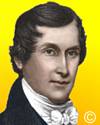
On 8 Sep 1790, Canvass White was born, an American civil engineer, who built canals. In the course of this work, he developed the first process for making hydraulic cement in the United States, for which he obtained a patent. To research his projects, he spent several months in England to study the details of canal construction and navigation. To build locks, a suitable cement was needed, which would have been available from England only at considerable expense. After repeated experiments, White located a suitable stone and devised the process to manufacture a cement with the necessary properties.
Canvass White was also instrumental in forming a company to develop water power and create a manufacturing town in Cohoes County, New York. Being so important to its origin, his obituary appears in The History of Cohoes, N.Y. (1877). This article gives more background of one of the engineers whose mechanical ingenuity and inventive genius contributed much to the growth of important infrastructure in the United States.
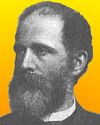
On 9 Aug 1897, Viktor Meyer was born, the German organic chemist who contributed greatly to knowledge of both organic and inorganic chemistry and invented an apparatus for determining vapour densities (and hence molecular weights), now named after him.
If you took a chemistry course, chances are, you came across mention of this apparatus. To know more about the accomplishments of this interesting chemist, read this short biography of Viktor Meyer.

On 8 Sep 1965, Joshua Lionel Cowen died, the American inventor of electric model trains who founded the Lionel Corporation (1901), which became the largest U.S. toy train manufacturer. At age 18, he had invented a fuse to ignite the magnesium powder for flash photography, which the Navy Department bought from him to be a fuse to detonate submarine mines. At age 22, he created a battery-powered train engine intended only as an eye-catcher for other goods in a store window. To his surprise, many customers wanted to purchase the toy train. Thus he started a model railroad company. Today's book pick is: All Aboard!: The Story of Joshua Lionel Cowen & His Lionel Train Company, by Ron Hollander who covers everything: humble beginnings, postwar boom, near destruction at the hands of famed veteran of the "Red Scare" Roy Cohn to its present day owners. If you had Lionel trains as a child or have always loved them from afar, you'll find this an engrossing read. Cowen is honestly portrayed, who like many successful people, could at times be a bully, tyrant, and egomaniac. The book also is a testament to how this producer of toy trains dealt with the competition of electronic games at the end of the 20th century and is experiencing a surge of popularity at the beginning of the 21st Century.
It is available from Amazon, typically about New from $40.01. Used from $3.50. (As of earlier time of writing - subject to change.)
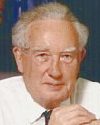 | I do not believe that the present flowering of science is due in the least to a real appreciation of the beauty and intellectual discipline of the subject. It is due simply to the fact that power, wealth and prestige can only be obtained by the correct application of science. |
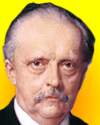 | Isolated facts and experiments have in themselves no value, however great their number may be. They only become valuable in a theoretical or practical point of view when they make us acquainted with the law of a series of uniformly recurring phenomena, or, it may be, only give a negative result showing an incompleteness in our knowledge of such a law, till then held to be perfect. |
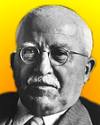 | The most fundamental difference between compounds of low molecular weight and macromolecular compounds resides in the fact that the latter may exhibit properties that cannot be deduced from a close examination of the low molecular weight materials. Not very different structures can be obtained from a few building blocks; but if 10,000 or 100,000 blocks are at hand, the most varied structures become possible, such as houses or halls, whose special structure cannot be predicted from the constructions that are possible with only a few building blocks... Thus, a chromosome can be viewed as a material whose macromolecules possess a well defined arrangement, like a living room in which each piece of furniture has its place and not, as in a warehouse, where the pieces of furniture are placed together in a heap without design. |
| Before you look at today's web page, see if you can answer some of these questions about the events that happened on this day. Some of the names are very familiar. Others will likely stump you. Tickle your curiosity with these questions, then check your answers on today's web page. | |
| Births | |
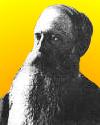 | Raphael W. Pumpelly, born 8 Sep 1837, was an American geologist and scientific explorer known for his studies and explorations of ore deposits for which he used microscopes and thin sections for petrographic study What metal did he advise investors to search for instead of gold? |
 | Marin Mersenne, born 8 Sep 1588, was a French mathematician, natural philosopher, and theologian whose discovery of the Mersenne numbers is considered to have been a pioneering effort to derive a formula that would represent all prime numbers. What formula is the form of Mersenne numbers? |
| Deaths | |
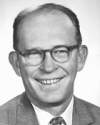 | Willard Frank Libby (1908-1980) was an American chemist who developed a tool of interest to archaeologists, anthropologists, and earth scientists for which he was honoured with the Nobel Prize for Chemistry in 1960. What is the process he developed? |
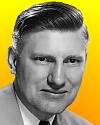 | Harry G. Day (1906-2007) was an American nutritional biochemist who helped co-developed the fluoride additive used in toothpaste to combat tooth decay. Proctor and Gamble funded his research at Indiana University. After FDA approval, in Jan 1956, Crest toothpaste was introduced with this ingredient, which they called fluoristan. Which chemical compound was called fluoristan? |
| Events | |
 | On 8 Sep of a certain year, an early report in the Journal of the American Medical Association held that there is statistical evidence connecting smoking and heart disease. What was the decade of this event? |
| no image | In 1854, Dr. John Snow removed the handle of the Broad Street water pump in London, which is remembered as one of the most symbolic gestures in the history of public health. The “John Snow” pub now stands beside the pink granite slab marking the site of the original pump. Why did he remove the pump handle? |
Fast answers for the previous newsletter for September 7: James Alfred Van Allen • chemistry • photosynthesis • magnetron • decade of 1888.
 If you enjoy this newsletter, the website, or wish to offer encouragement or ideas, please send feedback by using your mail reader Reply button.
If you enjoy this newsletter, the website, or wish to offer encouragement or ideas, please send feedback by using your mail reader Reply button. Your click on a Facebook, StumbleUpon, or other social button on the site webpages is also a welcome sign of appreciation. Thank you for using them.
© This newsletter is copyright 2020 by todayinsci.com. Please respect the Webmaster's wishes and do not put copies online of the Newsletter — or any Today in Science History webpage. (If you already have done so, please remove them. Thank you.) Offline use in education is encouraged such as a printout on a bulletin board, or projected for classroom viewing. Online, descriptive links to our pages are welcomed, as these will provide a reader with the most recent revisions, additions and/or corrections of a webpage. For any other copyright questions, please contact the Webmaster by using your mail reader Reply button.
--
If you do not want to receive any more newsletters, Unsubscribe
To update your preferences and to unsubscribe visit this link
Executive Real Estate Business Class
-
"It was like a man with wings. It wasn't like anything you'd see on TV or in a monster movie." ...
About the publisher
Search This Blog
Blog Archive
-
▼
2020
(1542)
-
▼
September
(173)
- SCIENCE: Just how big is Everest?
- The Latest News from History News Network
- On This Day for September 30 - Munich Agreement si...
- We are called to return to our foundational values...
- Newsletter for Wednesday 30 September.
- They Killed His Wife And Left Him For Dead – Then ...
- TRAVEL: Telling new truths about America’s histori...
- Make learning fun with Nat Geo Kids magazine! Subs...
- On This Day for September 29 - British mandate in ...
- Newsletter for Tuesday 29 September.
- Special Edition: Dinosaurs come to life like never...
- September 29: On This Day in History
- HISTORY: America's most endangered historic sites
- New This Week on History News Network
- On This Day for September 28 - California “discove...
- Newsletter for Monday 28 September.
- September 28: On This Day in History
- FAMILY: What do I tell my kids about wildfires and...
- On This Day for September 27 - Norman Conquest beg...
- Newsletter for Sunday 27 September.
- September 27: The Rosetta Stone, E=mc² and Fear as...
- The Compass: Indonesia
- On This Day for September 26 - First televised U.S...
- Newsletter for Saturday 26 September.
- September 26: Frances Drake's Circumnavigation, th...
- CORONAVIRUS UPDATE: Is this the end of the office?
- PHOTOGRAPHY: They feed us. Now we see them.
- The assassination of Lord Mountbatten | Enola Holm...
- 39,500-Year-Old Cave Bear Discovered Perfectly Pre...
- On This Day for September 25 - Pacific Ocean sight...
- The Roundup Top Ten for September 25, 2020
- Newsletter for Friday 25 September.
- September 25: Battle of Stamford Bridge, Remote Co...
- ANIMALS: These mighty elephants find peace
- On This Day for September 24 - Federal troops sent...
- Newsletter for Thursday 24 September.
- Global cartels taking control of the world + HPA B...
- September 24: Decline of the Byzantine Empire, Ope...
- YOUR WEEKLY ESCAPE: America's oldest mystery
- SCIENCE: How to cope with a big death toll
- The Latest News from History News Network
- On This Day for September 23 - Neptune observed, J...
- Newsletter for Wednesday 23 September.
- September 23: Nintendo, the Start of Data Processi...
- TRAVEL: How will America’s state parks survive?
- Matching gift opportunity for Sumatran rhinos
- On This Day for September 22 - Solidarity formed, ...
- Newsletter for Tuesday 22 September.
- September 22: Salem Witch Trials, Iraq's Invasion ...
- HISTORY: Who can replace RBG?
- Feed their curiosity! Get Nat Geo Kids magazine fo...
- New This Week on History News Network
- On This Day for September 21 - Joseph Smith's visi...
- Newsletter for Monday 21 September.
- September 21: France, China and a Sheep Shearing R...
- FAMILY: Don’t tell your kids outdated stuff about ...
- On This Day for September 20 - Rome incorporated i...
- Pro-life is not Politics + Vickie Travis's message...
- Newsletter for Sunday 20 September.
- September 20: Attila the Hun, Magellan's Circumnav...
- The Compass: Chile
- Matching gift opportunity for Sumatran rhinos
- On This Day for September 19 - George Washington's...
- Newsletter for Saturday 19 September.
- CORONAVIRUS UPDATE: Young people are spreading the...
- September 19: 1st Country to Grant Women the Right...
- PHOTOGRAPHY: How to make dinos look new (CORRECTED)
- Quick Note: How to Save Videos by Downloading
- PHOTOGRAPHY: How to make dinos look new
- The Mayflower | Medieval spiders | Ancient Egypt f...
- When She Found Out Her Boyfriend Was A Serial Kill...
- The Roundup Top Ten from History News Network
- On This Day for September 18 - Mukden seized by Ja...
- Newsletter for Friday 18 September.
- "Truth Crushes Evil" + We're Winding down + What ...
- YOUR WEEKLY ESCAPE: The country that doesn't exist
- September 18: Great Fire of Moscow, the CIA and El...
- ANIMALS: How U.S. officials stopped the flying squ...
- Two New Podcasts From HISTORY
- Don't miss out: back to school savings for learner...
- On This Day for September 17 - Camp David Accords ...
- Newsletter for Thursday 17 September.
- September 17: Bloodiest Day in the American Civil ...
- SCIENCE: He found part of a one-of-a-kind dinosaur
- SPECIAL REPORT: How the West is primed to burn
- The Latest News from History News Network
- On This Day for September 16 - Mayflower's departu...
- Newsletter for Wednesday 16 September.
- September 16: French Abolish Slavery, Malaysia For...
- TRAVEL: Will slowing down help you get stronger?
- Special Report: How do we end this pandemic?
- On This Day for September 15 - Central Americans g...
- Newsletter for Tuesday 15 September.
- September 15: Darwin Reaches the Galapagos, Penici...
- HISTORY: How the U.S. battled catastrophic wildfir...
- BREAKING NEWS: Possible evidence of life found on ...
- Discover Remarkable Leaders With Nat Geo History M...
- On This Day for September 14 - Mexico City capture...
- New This Week on History News Network
- Newsletter for Monday 14 September.
-
▼
September
(173)
-
Blogroll
-
About
HistoryFact










0 comments:
Post a Comment